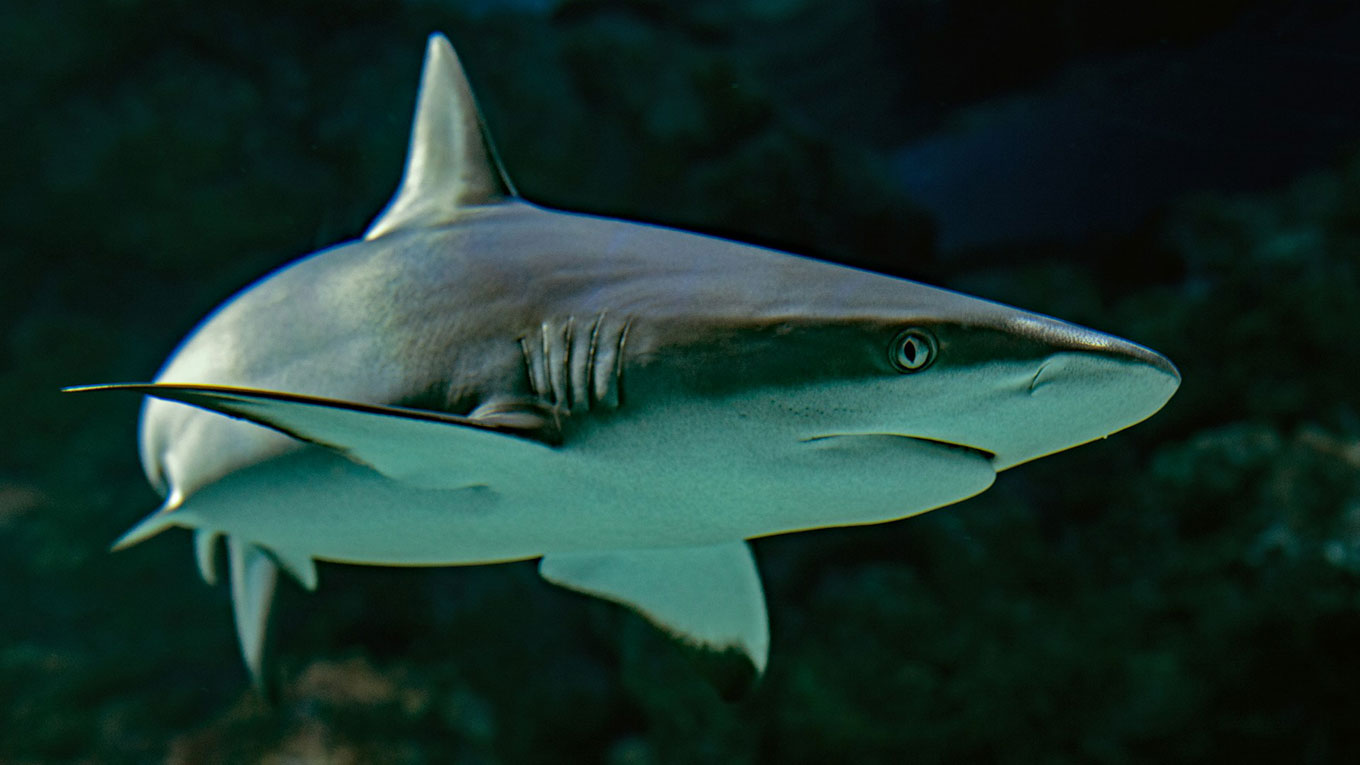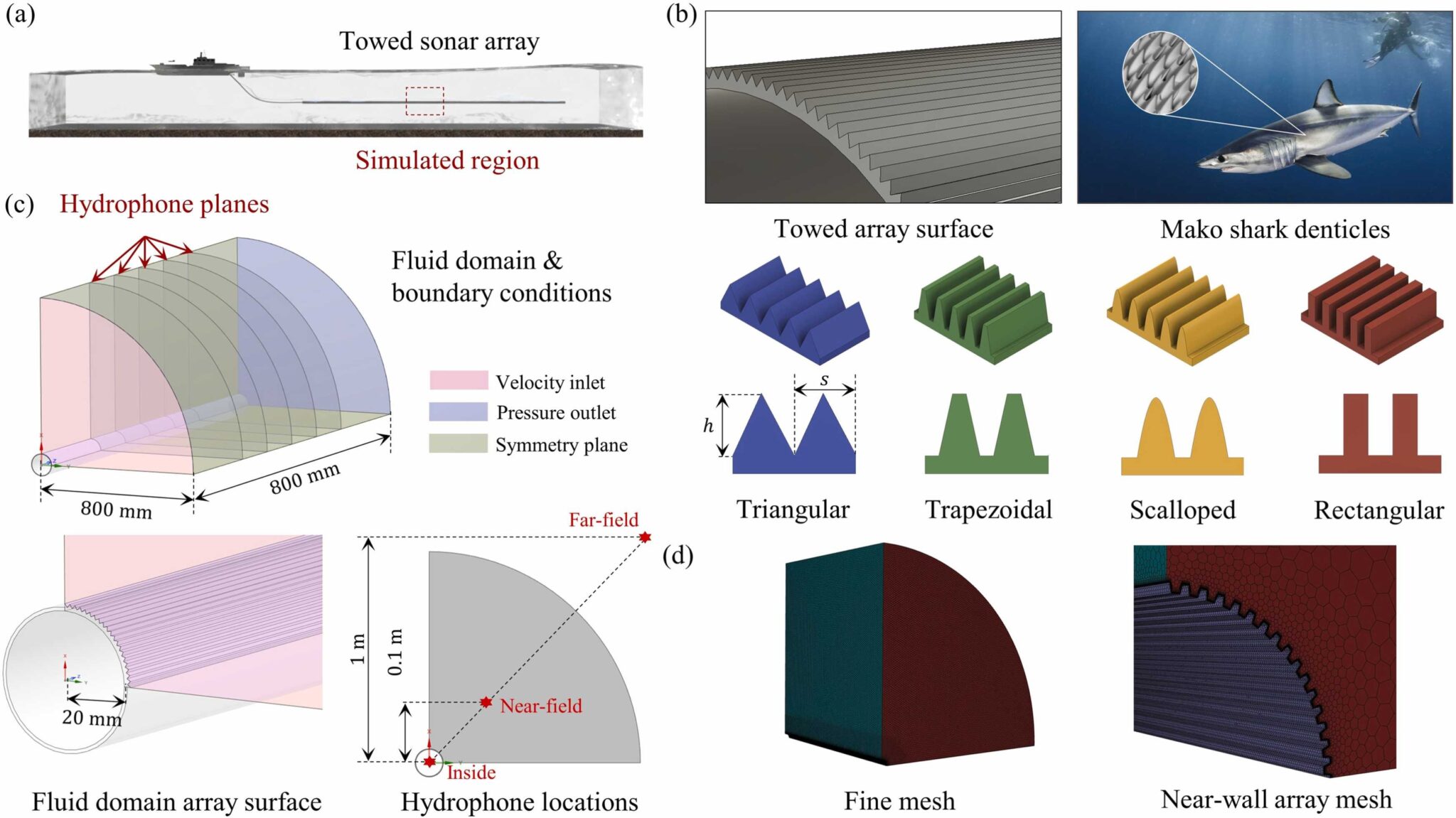Bioinspired Design Reduces Drag and Noise Production for Towed Sonar Arrays

Textured surface mimics shark skin to make underwater instruments more effective and environmentally friendly
Submarines and ships rely on towed sonar arrays (TSAs) for underwater exploration and security operations, but dragging these sensors through water, especially at high cruising speeds, creates excess noise that can mask target signals and compromise the sonar’s detection capabilities. Now, a team of Berkeley engineers is attempting to solve this problem with a little inspiration from Mother Nature.
In a study recently published in Extreme Mechanics Letters, researchers from Berkeley, in collaboration with MIT Lincoln Laboratory, demonstrate how a textured surface designed to mimic shark skin can reduce drag and mitigate flow-based noise, potentially opening the door to a new generation of more effective and efficient TSAs.
“Past studies have shown that the unique patterns on shark skin, known as riblets, can reduce drag,” said Grace Gu, assistant professor of mechanical engineering and principal investigator of this study. “We hypothesized that such bioinspired topographies could similarly reduce noise production in an underwater context and set out to adapt these naturally occurring designs to the surfaces of sonar arrays.”
According to the researchers, the idea of using riblets for noise suppression was inspired by yet another natural texture, serrations, which are known to help owls achieve silent flight and used on surfaces to mitigate noise in aeronautic systems.
To test their theory, the researchers used computational modeling to simulate riblet surfaces with different shapes and patterns and then simulated the movement of water around these engineered riblet surfaces on the arrays. This virtual testing environment enabled them to assess how different riblet designs affect fluid behavior and the acoustic properties of the sonar arrays under various flow conditions — from smooth, predictable laminar flows to the more common, chaotic turbulent flows encountered in natural marine environments.
Of the many riblet designs tested — including smooth, triangular, trapezoidal and scalloped — the rectangular riblet design proved to be the highest-performing prototype. It was the most effective at both diminishing the noise generated by water flow and decreasing the hydrodynamic drag.
The magnitude of these improvements became particularly evident when conducting simulations with turbulent flows. Under these conditions, the rectangular riblets demonstrated a reduction in noise by up to 14.3%, along with a 5.1% decrease in hydrodynamic drag, in comparison to a smooth array surface. In addition, their parametric study revealed that riblets with finer, more closely spaced geometries can further reduce drag by another 25.7%.

“These findings underscore the efficacy of riblet geometries in different flow conditions, highlighting their potential in optimizing the acoustic and hydrodynamic performance of maritime systems,” said Gu. “The robust, dual-functionality potential of these microstructures could be a game changer for future TSA designs.”
In addition to advancing our understanding of how riblets affect acoustics, the study also shed light on the underlying hydrodynamic mechanism that drives noise suppression.
“Our study has revealed a pivotal process occurring within turbulent flows, where the intricately designed riblet-reinforced surfaces of sonar arrays play a key part in what we describe as ‘vortex lifting.’ The process involves redirecting the cores of coherent vortex structures, effectively elevating them away from the array’s surface while simultaneously diminishing their rotational strength,” said Zixiao Wei, a graduate student in the Department of Mechanical Engineering and first author of the study. “This elevation is key to reducing the intense pressure fluctuations that are generated by the interaction between the water flow and the array wall, leading to noise production.”
According to Gu, this bioinspired research could lead to key advancements in the functionality of underwater vehicles and instruments, with wide-reaching implications for many applications. And the quieter operation of these underwater devices also offers a significant benefit to the environment by reducing the impact on marine life.
Perhaps most important, this study showed how biological efficiencies can be translated into meaningful technological improvements. By continuing to take a bioinspired design approach, researchers may someday discover practical solutions to other engineering problems.
“The riblet patterns, akin to those found in nature, offered us a way to not only replicate but also optimize these natural solutions for human-made systems,” said Wei. “This work demonstrates the vast potential of biomimicry in advancing engineering and technology.”
Co-authors of this study include graduate students Zilan Zhang and Dahyun Daniel Lim from Berkeley’s Department of Mechanical Engineering, and Justin Rey and Matthew Jones from MIT Lincoln Laboratory. The study received support from MIT Lincoln Laboratory, CITRIS and the Banatao Institute, the National Science Foundation and the Prytanean Society.